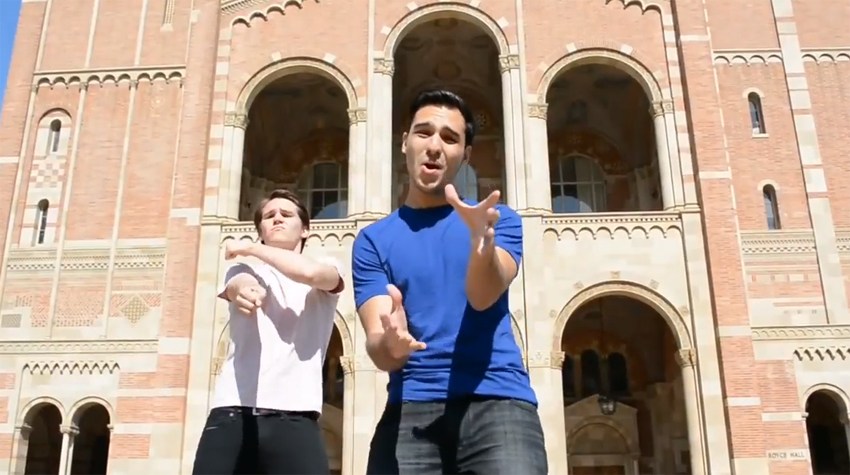
Students’ pop-song video parodies teach real science
It’s also hard to imagine the rapper Macklemore ever reshaping his parody “Thrift Shop” into an ode to the Coriolis effect. But those are two of the entertaining student-made music…
Beyoncé probably never considered repurposing her powerful song “Formation” for an earthquake preparedness anthem.
It’s also hard to imagine the rapper Macklemore ever reshaping his parody “Thrift Shop” into an ode to the Coriolis effect. But those are two of the entertaining student-made music videos that have appeared over the years in UCLA professor Aradhna Tripati’s classroom film festivals in “Intro to Oceanography.”
With thumping bass and catchy hooks, students are rewriting the lyrics to their favorite pop songs to impart some scientific knowledge. So the students learn, and, since they post the videos online, the public learns too.
Tripati, a paleoclimatologist and an associate professor of geology, offered extra credit in 2011 to her first oceanography class for projects that could be used to teach the public about topics like ocean acidification, wind, currents and subduction zones. After hearing glowing student feedback, she made the science communications project a required assignment for “Blue Planet: Intro to Oceanography,” yielding five years of sharable teaching tools, especially spoof music videos.
“They’re humorous, they’re sexy, they’re silly, and they’re really, really effective educational tools that reach thousands of people outside the class,” said Tripati, who’s also affiliated with UCLA’s departments of Earth, planetary and space sciences; atmospheric and oceanic sciences; and the Institute of the Environment and Sustainability.
Students in the class can recruit help from other Bruins, so one stand-out video was created by two students who were also members of the a capella group Bruin Harmony. The students have the double benefit of their own great voices along with the rest of the group singing their back-up vocals.
“Starfish” (2014) by Guilherme Apollonio and Chris Hunter with backing from Bruin Harmony, based on Nicki Minaj’s “Starship.”
“The projects that they make are really remarkable,” Tripati said. “I like it because it requires active learning. The projects get the students to think about the relevance of the course material to their lives and what they find most fascinating. Figuring out how to teach it to others helps them retain it.”
The most popular video remains one of the first, made in 2011. With more than 23,000 hits, it addresses overfishing and sustainability.
“Overfishing” (2011) by Neema Oshidary and Thomas Lessler, based on Wiz Khalifa’s “Black and Yellow.
While music videos are the most popular projects, students also turn in comic books, mixed-media sculptures, lesson plans for K-12 science curricula; mock disaster-movie trailers and even a climatological assessment of the fictional world of “Dune.” “The only requirements,” Tripati explained, “are that they be sharable teaching tools, related to the course material and scientifically accurate.”
Tripati, who recently made her own appearance in a viral video on the late-night comedy talk show, “Jimmy Kimmel Live,” said she’s consistently impressed with students’ instincts in constructing an effective narrative and their facility with filming, using stock imagery and editing the videos together.
Still, the task is challenging. As one student put it in his cleverly rewritten lyrics to Macklemore’s “Thriftshop,” the Coriolis effect is “really hard to put in a song.”
Inspired by Beyoncé’s Super Bowl performance of her massive hit “Formation,” two students used the imagery and music from the iconic song to discuss earthquakes and subduction zones. Although Tripati was vaguely aware of Beyoncé’s version, their subductive twist on “Formation” was the first time she listened to it all the way through.
“I tend to listen to more outdated music, so I’ll often get introduced to songs when they’re used for one of these videos,” Tripati said. “So I learn the tune, but the lyrics are, of course, totally different. Then I’ll be out somewhere or turn the radio on and finally hear the original song.”
https://vimeo.com/173920902
“Earthquake Prep” by Najwa Kaawach, Georgia Perris and Sophie Zollman, based on Beyoncé’s “Formation” (2016).
“In another great video about ocean acidification, they put in all these principles about ocean pH and marine calcifiers; to have ‘bicarbonate’ and ‘carbonate ion’ in a song is remarkable,” Tripati said. The video, with strong vocals and a goofy blue-screen effect, explains how carbon dioxide from pollution turns into carbonic acid in the ocean, resulting in destructive ocean acidification.
“Time to Change” (2013) By Thomas Li and Ryan Yoo, based on The Wanted’s “Glad You Came.”
“There was a brilliant one about winds and the Coriolis effect, created by a group of our student athletes,” Tripati said. The video starts slowly before morphing into a catchy lesson.
“Wind Spinnin’” (2013) by Jordan Merill, Cody Crampton, Blake Selig, Xavier Su’a-filo and Ahmad Harris, based on Tyga’s “Rack City.”
Tripati maintains a YouTube channel with a rolling list of the top 25 videos from the class over the years. There, anyone can guffaw over the entertaining rhymes and sometimes wobbly singing from videos like “The Great Garbage Patch,” based on One Direction’s “What Makes You Different,” or “Seafloor Spreading,” which turns “Let it Go” from the movie “Frozen” into a lesson on lava, tectonics and subduction zones.
Part of Tripati’s goal is to keep the class interesting for her students, who will rarely major in oceanography. In a class that can range from 70 to 400 students, she knows their academic interests are widely divergent.
But the goal of communicating science to an even larger audience is never far from her mind.
“I’m always looking at things like TED talks,” she mused. “With the right approach, one person can communicate so widely.”
This story was originally posted on the UCLA Newsroom website
Published:



